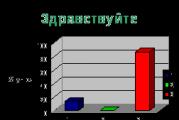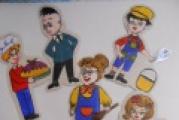I want some seeds: how quickly do you peel the seeds from the husk? How to make a harvester for peeling the shells of sunflower seeds How to separate empty sunflower seeds from full ones
Good day to all, dear friends! In today's article, I would like to look at a very interesting homemade product with you. Namely, in this article we will look at how to make a harvester for peeling sunflower seeds from the shell. This food processor can be useful for those who love kozinaki and want to make them themselves. Of course, you can find shelled sunflower seeds in grocery stores, but they are not available everywhere. And if you also haven’t found the peeled seeds and still the desire to make homemade kozinaki does not leave you, then this homemade product is for you. As always, the maximum available materials for assembly will be selected so that anyone can make this homemade product. In general, the homemade product is very interesting, so let’s not delay with a long introduction, let’s go!
For this homemade product we will need:
- Large sheet of plywood
- A round wooden stick (for example, from a wooden clothes hanger)
- Self-tapping screws
- Aluminum cola can
- Not a large sheet of thin plastic (like plastic from a document folder)
- Electric motor from DVD drive
- Electric motor with gearbox (which comes with Arduino)
- Switch
- Furniture nails.
We will also need the following tools:
- Ruler
- Black capillary or gel pen
- Compass
- Jigsaw
- Hand jigsaw
- Drill and drill bits
- Hacksaw for metal
- Medium grit sandpaper
- Stationery knife
- Scissors
- Hot-melt adhesive
- Heat shrink
- Hammer
- Super glue.

First we need to cut out all the parts we need from plywood. To do this, we need a ruler and a black helium or capillary pen; we mark all the necessary elements on a sheet of plywood (see photo). More detailed information about each element will be described below. Having noted everything that we need, we cut out the elements with a jigsaw or an ordinary hand saw.


Then we should make probably the most important part of the homemade product, namely the threshing shaft. A shaft that will split sunflower seeds. To do this, we should take a round wooden stick (for example, from a wooden clothes hanger). In the stick you took, you should make two through holes at a distance of about 5 mm from each other. We screw two small screws into the holes we just made, then on the other side the protruding part of the screws should be sawed off with a hacksaw (or a grinder, as, for example, the author of the homemade product did). From the stick itself we saw off a section with self-tapping screws about 5-6 cm, and then make a longitudinal hole (see photo).




We continue to produce blanks for assembling homemade products. For the next step we will need an ordinary aluminum cola can and medium-grit sandpaper. We take the can and rub it on sandpaper from the ends on both sides so that the upper and lower parts of the can are detached from the main part of the can.



Then a square hole should be made on the cylinder just made from an aluminum can. In order to make a hole in an aluminum cylinder, you should use a stationery knife and make a hole exactly the same as in the photo below.


The next piece will be the propeller. To make a propeller, we need a small piece of thin plastic that can be cut from the cover of a document folder. To do this, take a compass and set the span on it so that the diameter of the circle it produces is equal to the diameter of the hole in the aluminum cylinder. We cut out the drawn circle using ordinary scissors, and also make longitudinal cuts so that in the end we get 8 blades. The cut blades should be bent to one side.



Having prepared the main elements, we begin assembly. To begin with, you should glue a screw to the aluminum cylinder, which should also be made from an aluminum can. To do this, cut the can lengthwise and unfold it to create a flat aluminum plate. Then we cut out a rectangle from the aluminum plate using ordinary scissors. We bend the edges of the cut out rectangle so that the flying seeds do not fly over the edges. You can glue two aluminum blanks using super glue or double tape, as the author of the homemade product actually did.

Next we will need two plywood parts that we made at the very beginning. Namely, we will need two rectangles with holes in the upper part, the diameter of which coincides with the diameter of the aluminum cylinder. We connect the aluminum blank with the plywood blanks as shown in the photo below.

After which we will need the largest plywood rectangle, it will serve as the basis of the homemade product. Using hot glue, glue the newly made piece to the plywood rectangle. But an ordinary connection using hot glue alone is not enough, so you should strengthen the connection with furniture nails.



The next step is to manufacture the main part of the structure, or, to be more precise, the most important part. Let's take the "L" shaped part that we cut out at the very beginning. A small aluminum rectangle should be glued to this part in the location indicated in the photo. The wall should be glued to the same part to the long side, in the wall which we will install, a hole should be made for the electric motor shaft. It is needed for the shaft on the opposite side, since we only need the shaft on one side, but not on the other, so to save space for installing the motor close to the wall, we need this hole. We glue the wall and the electric motor with the gearbox close to it. On the gearbox shaft we put the blank to which the self-tapping screws were previously screwed.



We finish the remaining walls, leaving a hole at the bottom for the seeds to come out, and a hole at the top for the seeds to enter. To the same structure we will glue a kind of “bunker” into which the not yet peeled seeds will be poured. To do this, we glue a rectangle to the side indicated in the photo at an angle, and as side walls we take and cut out some pentagonal shapes (see photo) from thin plastic. And glue the walls to the mechanism.



Using hot-melt adhesive, we glue the newly made mechanism to the workpiece made earlier. And securely fix it with self-tapping screws.


Then we take the electric motor from the DVD drive, and install the propeller made earlier on its shaft. We glue this electric motor to a rectangular plywood board. And we will install the board itself opposite the hole in the cylinder so that when the electric motor shaft rotates, an air flow is created that will blow the husks from the sunflower seeds out of the cylinder. Then, to ensure that the newly installed board does not fall off, you should glue a spacer between the board and the wooden base of the cylinder.





Then you should solder the entire electronic part of the structure. Namely, connect the electric motors in parallel so that the gearbox shaft rotates towards the aluminum reinforcement inside the mechanism, and the propeller creates an air flow towards the aluminum cylinder. And all this is connected to power through a switch, which should be glued to the structure.
In chapter Garden Garden to the question How to peel sunflower seeds at home, The simplest homemade devices asked by the author I The best answer is that Russians don’t buy peeled seeds because they enjoy clicking them, not eating them. They spit so much dirt :) Sit down near an interesting movie and start playing, and let the cat help. My mom’s dog can also crack sunflower seeds.
Long winter evening, a tray of roasted sunflower seeds for each family member, put on an interesting movie - two bags can be cleaned during the winter.))))))))
And let Vaska work too! There has never been such a task. You can try a linen bag and iron it with a rolling pin, the main thing is that the peel is opened.
Look on the market, there are mini harvesters with attachments.
How to quickly peel 1 kg of seeds
Peeling seeds manually at home is extremely simple. To do this, you just need to follow a few steps sequentially. Watch the video! Specially…
Especially for those who love seeds, but really don’t like peeling them themselves. A great way to clean seeds. To be honest, it never even occurred to me that it would be so simple.
Well, let’s take the advice and clean the seeds together.
How to peel seeds at home
The seed crusher is designed to remove the husks from the seeds.
The sunflower seed is poured into a bunker (the volume of the bunker is 50 kg of seeds), and the size of the gap through which the seed falls onto the crushing drum is adjusted using a gate. The seed must first be calibrated to one size (to increase the quality of hulling). At the end of the day, we get a clean kernel, half-grown, flour and husk in the total mass.;
At the exit after Petkus, we get a separate clean kernel (may contain 3-5% under-rush), under-rush, flour and husk;
In order to 100% clear the entire kernel from the waste it contains (3-5%), a vibrating pneumatic table is used.
Power - 3 kW;
Voltage - 380 W;
The percentage of under-destruction is up to 10%/hour;
The yield of the whole core is 50% (of the total mass of the load at the input);
The hulling machine is used in butter churns, lines for the production of kazinaki, halva, lines for the production of fried sunflower seeds;
When using the Centrifugal seed crusher CB-250 in the production of sunflower oil, we obtain an increased oil yield due to the fact that the remaining oil is not absorbed by the husks, which we have already removed. The oil yield is 5% higher using the CB-250 seed crusher. ;
In Russia, many people love delicious sunflower kernels. What's a vacation without a pack of roasted sunflower seeds? Interestingly, in Japan the seeds are only given to rodents for consumption. The fact is that not all Japanese have tried delicious kozinaki, so they use this product exclusively for animals.
How do you peel seeds from the husks at high speed?
On a large scale, for the same kozinaki, sunflower kernels are cleaned using special machines. But first, the seeds must be dried, only then can the installation cope with its task.
They are cleaned of dirt so that it does not fall on the nucleoli that have already been freed from the husk. Afterwards, the seeds are placed in a bunker specially made for this purpose. They stay there for some time. Next, the sunflower seeds are selected based on size. The shells are separated from the seeds on a drum. But this process will not be a complete cleanup.
Some seeds may still have a husk left on them due to incomplete drying of the kernel or tight seal of the skin. Cleaned seeds are separated from debris using a winnower and a cyclone. Final cleaning takes place on the table. It makes vibrating movements, and the seed is completely freed from the husk.
How to peel seeds at home?
It is clear that even seed lovers do not have special installations for cleaning them, so everyone adapts as best they can. Moreover, the more often this activity is practiced, the faster it is possible to release the seeds for husks. Sometimes, even at home, you need to peel a large number of seeds, and not into your mouth, but, for example, into some dish. They can be salads or baked goods. The question arises, how to quickly peel the seeds. The answer is to use a blender:
Pour the seeds into the blender and turn on for a short time;
Pour the seeds into a container and fill with water;
The husk will end up on the surface, and the heavier kernels will end up at the bottom of the container.
Most often, we clean the seeds directly into our mouths and use two methods for this.
In the section on the question Sunflower seeds, how are they cleaned at the factory!!! given by the author Alexey Levshov the best answer is Probably Tajiks.
Answer from Mademoiselle Spring[active]
manually)) just a joke... but in general - I don’t know, it was most interesting...
Answer from Wake up[active]
First, they undergo a crushing process on a disc-drum device, and then, by blowing with an air stream, the seed kernels are separated from the husk.
Answer from compound[active]
oni cistyat ee s SCM (Semecko Cistitelnaya Mashina).
Answer from Alex Mishin[guru]
In one book on food industry technology I found how to pit cherries. It turns out, just like at home - with a plunger. Only multi-channel and with automatic loading of cherries into the holes and unloading of peeled cherries. There was no way to clean seeds or, for example, pine nuts. Yandex also doesn’t find anything relevant.
Answer from Yokory Assistant[guru]
First, pre-calibrated seeds are fed to a steam-frying conveyor (the steel mesh of the conveyor passes several steam coils in succession) where they are calcined to t-110-115 degrees, under the influence of evaporating moisture the seeds open and then (hot!) are fed along the conveyor into the top loading hopper, from where weak It flows like a stream onto the blades of a fan with a DC motor (for precise control of speed). When it hits the blades, the seed peels off, the lighter husk is carried away by the air flow, and the heavier kernel falls into the receiver. Voila. I once installed such a line myself.
Answer from Nata Spot[newbie]
Specific peeling machines are used here. The mechanism of their operation is as follows: first, seeds (up to 50 kg) are loaded into a special hopper. Then the size of the gap in the crushing drum is calculated. In order for all the seeds to be cleaned equally well, they try to select grains of approximately the same size. The seed passes through the slot, falls onto the drum and is separated into a clean grain and husk. In this case, peeled grains may contain about 3% husk, which is additionally peeled off.
Raw and roasted pumpkin seeds do more than just serve as a nutritious snack. Fragrant and dense seeds are often used in cooking, acting as a main or additional component. This is where housewives begin to think about how best to peel pumpkin seeds. If you use the traditional manual method, you will have to spend a lot of time and effort on the procedure. It is better to use a proven approach that will allow you to get a high-quality product in the required volume in just a few minutes.

How to choose delicious pumpkin seeds?
The best pumpkin seeds are those that are extracted from the vegetable and processed yourself. Even the highest quality store-bought product cannot compare with them in terms of taste and level of beneficial components. Well, it’s generally better not to buy already peeled seeds, even if they are thoroughly cleaned and securely packaged.
When buying raw or roasted pumpkin seeds, you need to remember the following points:
- You need to choose thoroughly washed seeds, otherwise mold fungi will settle on the remaining vegetable pulp and you won’t be able to store them for a long time. To check the quality of pumpkin seeds, you just need to touch them (it is advisable to wet your fingers before doing this). If the products stick to the skin, they are not washed properly.
- You definitely need to smell the product. If it emits a specific rotten smell, the kernels may be damaged by something. In this case, the pumpkin seeds will be bitter and ruin the dish.

Advice: The more active the heat treatment of seeds, the less useful components remain in them. If you plan to use the kernels for therapeutic purposes, then it is better to avoid frying them in favor of drying them in the fresh air.
- Fried products should be firm to the touch. If the husk is soft, the component was prepared incorrectly.
A high-quality product is not only tastier and healthier, it is even easier to clean. In many ways, for this reason, experienced housewives prefer to harvest pumpkin seeds themselves.
How to get and prepare seeds with your own hands?
To obtain a therapeutic effect from eating pumpkin seeds, it is enough to consume about 10 g of purified raw product per day. And it’s best not to buy it from hand, but to prepare it yourself according to this scheme:

- Cut the pumpkin into two halves and take out the seeds. We remove the pulp from their surface and rinse it repeatedly in a colander under running water, achieving an ideal result.
- After the excess moisture has drained, place the seeds in one layer on a baking sheet covered with parchment paper. Place it in the oven and dry it, stirring regularly.
- There is no need to try to quickly achieve the desired result. It is better to set the minimum temperature and open the oven door slightly. The heat coming out of the chamber should not burn your hand.
- Now all that remains is to clean the products. Here you need to proceed differently than with fried ingredients; you will have to use scissors. Using them, we cut off part of the peel, moving from the middle of the seed, passing along the sharp edge to the middle of the opposite side. We extract the core from the resulting pocket.

If a therapeutic effect is not the goal, then pumpkin seeds are additionally fried. In this case, the husk becomes much denser and it becomes possible to clean such components without using scissors.
We clean pumpkin seeds in large quantities at once
There are several ways to mass clean a product. Here is one of the most effective and simple:
- Place the pre-washed and dried ingredients on a tray or baking sheet and lightly roll them out with a rolling pin. We need to break the integrity of the shell, but not damage the kernels themselves, so we don’t press too hard.
- Pour a saucepan into water at the rate of 1 liter of liquid per 0.5 kg of pumpkin seeds, bring it to a boil. Pour the products into boiling water and keep them on low heat under a closed lid for 20-30 minutes. We monitor the process - the husk should float to the surface.
- As soon as this happens, use a slotted spoon to remove dirt from the surface of the water, and drain the rest into a colander. The kernels should settle to the bottom, so all that remains is to collect and inspect them. If the husks have not come off from some elements, they are cleaned manually.
- All that remains is to wash and dry the seeds and you can use it for its intended purpose.

If you don’t want to bother with even such a simple process, you should take a closer look at pumpkins whose seeds are not covered with a protective shell - they don’t even need to be peeled. They can be grown independently in a personal plot or purchased at the market, in a store, or from farmers. In this case, the process of pre-treatment of seeds will be simplified even more. It will be enough to separate them from the pulp, rinse until clean, dry and, if necessary, fry.




